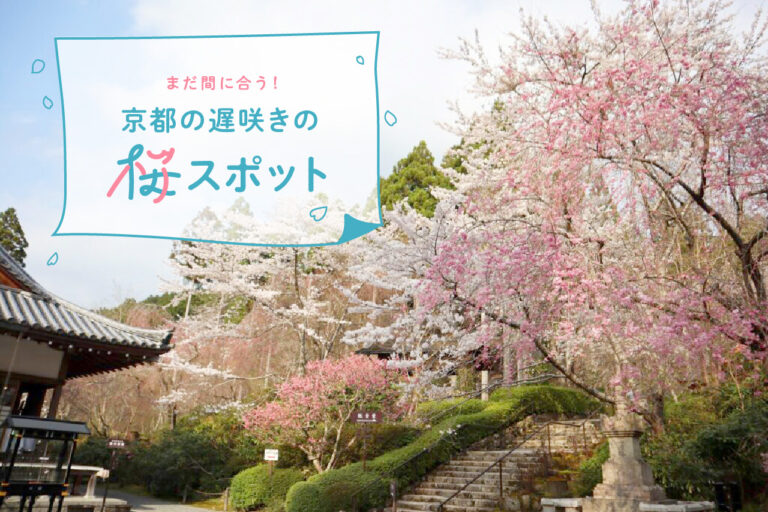
[2025] It's Not Too Late to Enjoy the Late Blooming Cherry Blossoms in Kyoto! Late Blooming Cherry Blossoms in Kyoto...
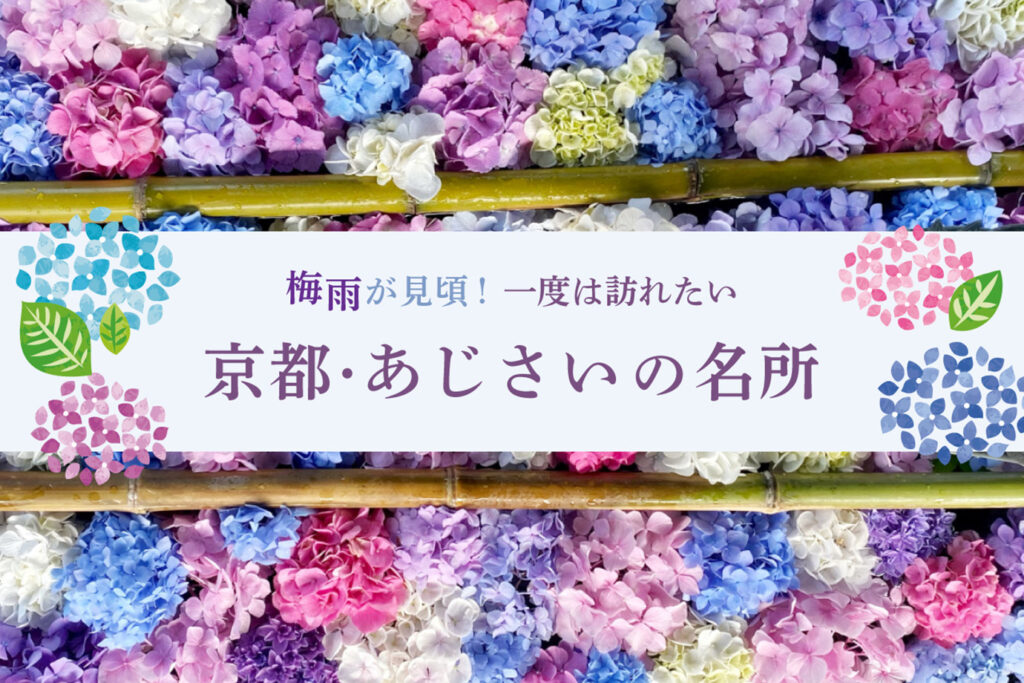

Every year in Kyoto, the hydrangea season begins in early June. In this issue, we would like to introduce some of the best places in Kyoto to visit now. The beauty of the colorful hydrangeas will surely soothe your heart. (TEXT/Koto Sakurai, EDIT/Moe Sawamura)
Sanzen-in Temple is known for its famous garden "Arikiyoen" with its beautiful cedar grove and moss, where thousands of hydrangeas are planted from Benzaiten to the front of Konjikinfudo Hall. The small hydrangea in mid-June is followed by the rare star hydrangea, and the pretty flowers can be admired until early July.
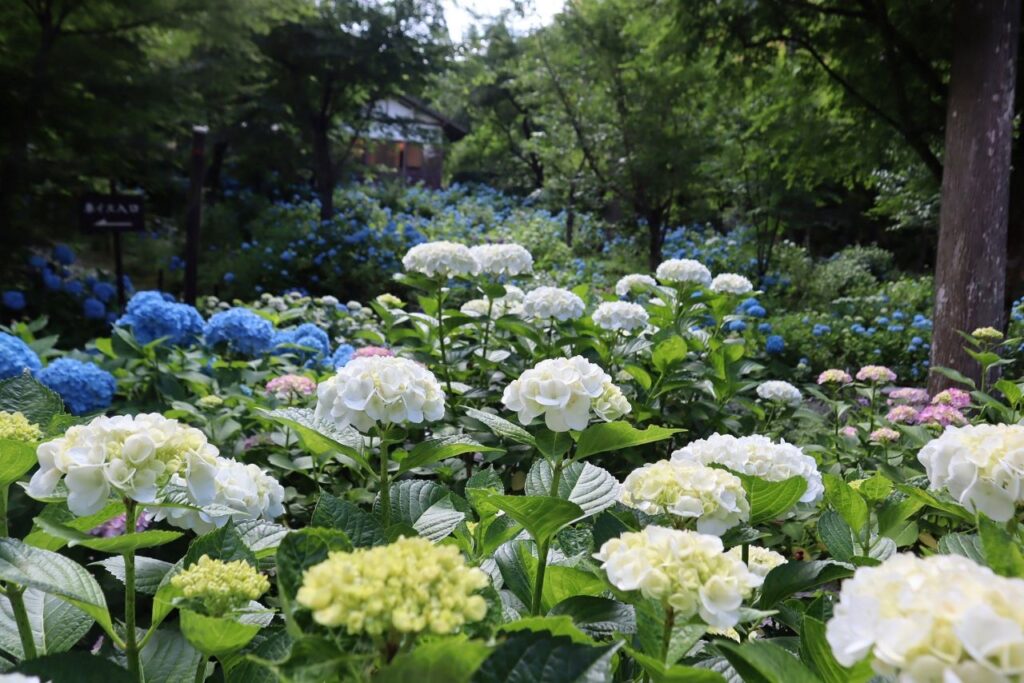

Hydrangea Festival
Best time to visit (usually): mid-June to early July
Period / Sunday, June 9, 2024 - Sunday, July 7, 2024 9:00 - 17:00
Admission fee: 700 yen for adults, 400 yen for middle and high school students, 150 yen for elementary school students
Mimuroto-dera Temple, known as one of the most famous flower temples in Kyoto, is also called "hydrangea temple. The temple is also known as "Hydrangea Temple" and is a famous sightseeing spot. 20,000 hydrangeas of about 50 varieties, including Western hydrangeas, bloom among the cedar groves, creating a picturesque scene.
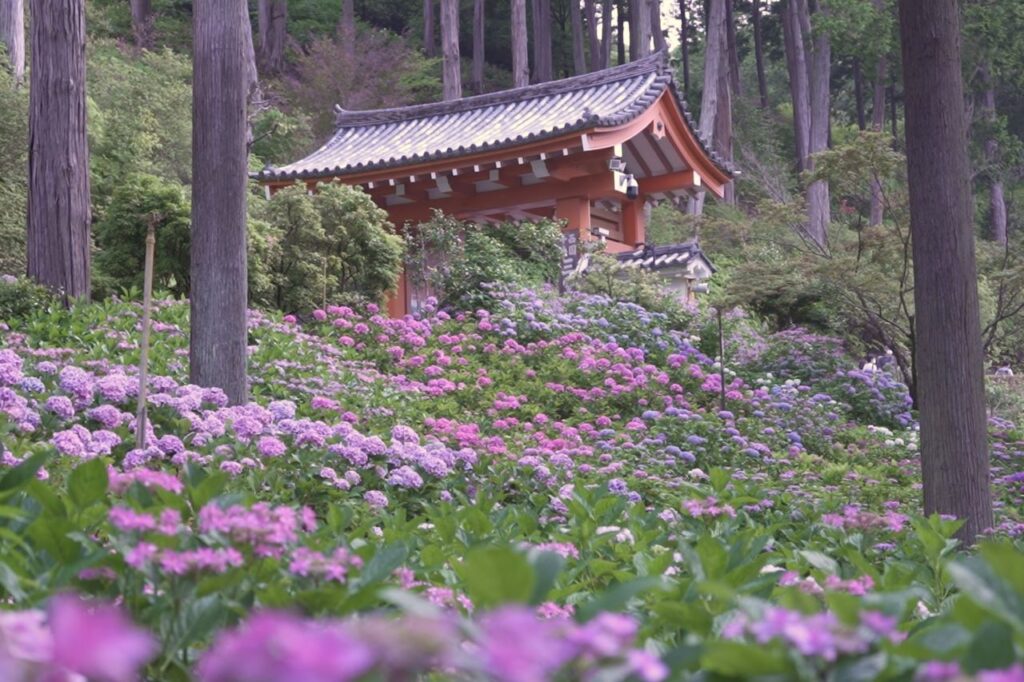

Opening of Hydrangea Garden
Best time to visit (usually): mid to late June
Period / Saturday, June 1, 2024 - Sunday, July 7, 2024, 8:30 - 15:40 (Mountain closes at 16:30)
Light up / Saturday and Sunday, 19:00 - 21:00, June 8 (Sat.) - 23 (Sun.), 2024 (last admission / 20:30)
Entrance fee: Adults 1,000 yen, children 500 yen
Day/night changeover system; only the hydrangea garden is open for viewing when the lights are up.
Fujimori Shrine is a shrine dedicated to the god of luck and the guardian of horses. There are two large hydrangea gardens on the shrine grounds, where 3,500 hydrangeas of various kinds bloom, including Western hydrangeas. On Saturdays and Sundays during the festival period, the shrine grounds become crowded with people as they hold dedication ceremonies such as kemari (Japanese game of foot throwing), taiko drums, and gagaku (ancient Japanese court music).
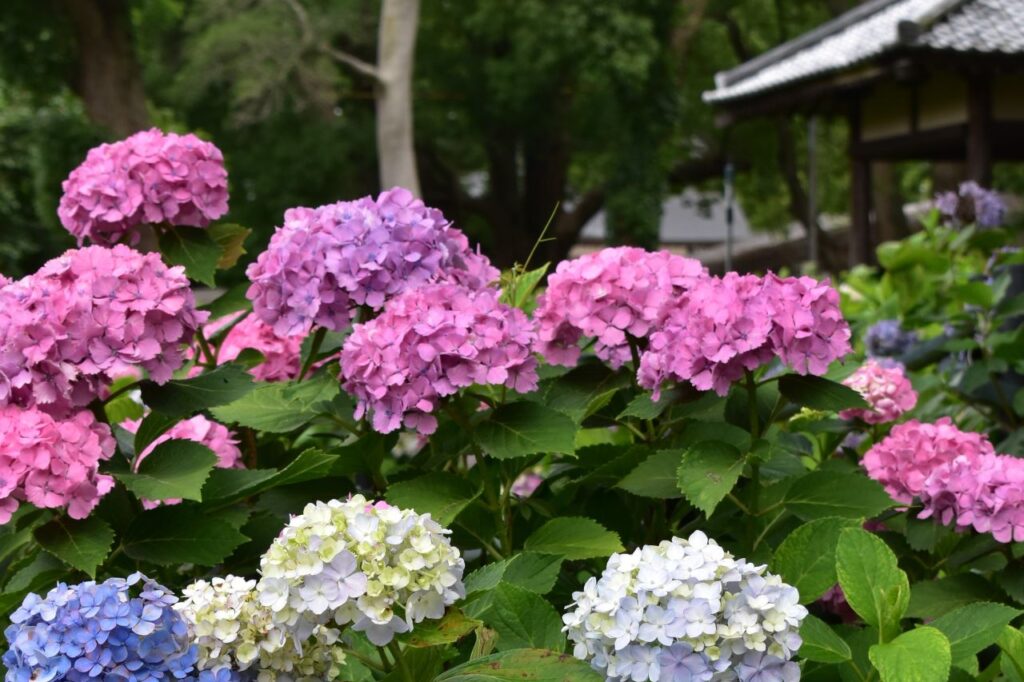

Hydrangea Festival and Hydrangea Garden open to the public
Best time to visit (usually): mid-June
Period: Saturday, June 1, 2024 - early July, 2024 9:00-17:00 *Schedule may change depending on blooming conditions.
Entrance fee / 500 yen
Event Schedule / June 15, 2024 (Sat) Hydrangea Festival ritual 10:00 (flower offering, tea ceremony, kagura dedication)
Chishakuin Temple is the head temple of the Chizan sect of the Shingon Sect, which has 3,000 branch temples. 2012 saw the construction of a hydrangea garden behind the main hall, where Western hydrangeas, gaku hydrangeas, and other flowers are planted. At the same time, the bellflower, which is used as the temple's emblem, blooms, creating a colorful and beautiful scene.
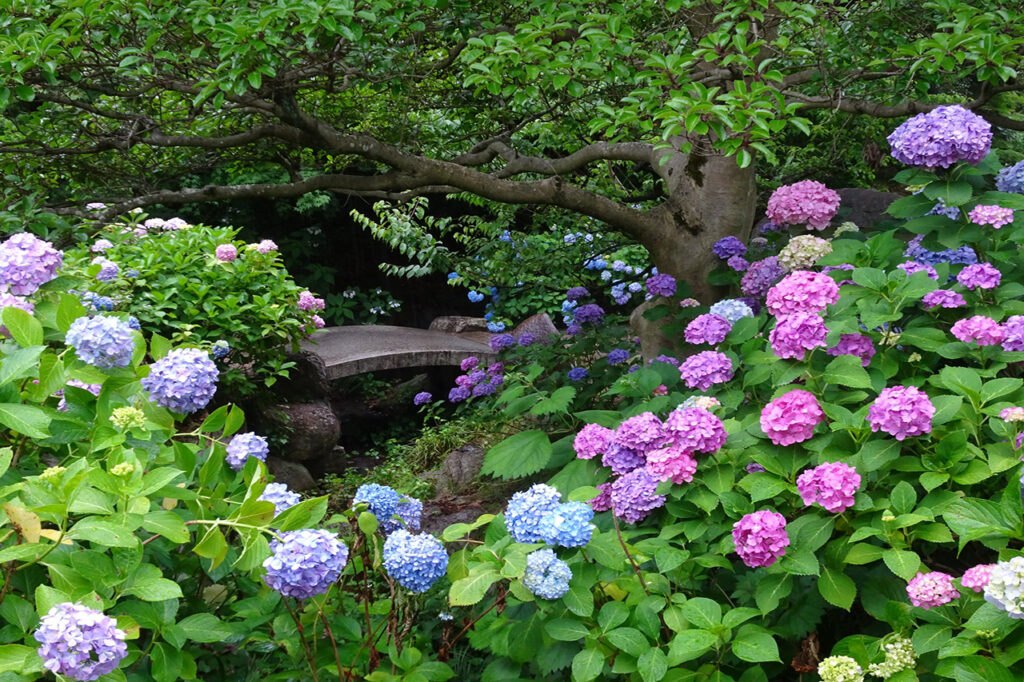

Hydrangea Garden open to the public free of charge
Best time to visit (usually): mid-June to early July
Hours of visitation: Free within the precincts of the temple *Hômonokan (Treasure House) and the famous garden 9:00-16:00
Admission fee: Treasure Museum: Adults 500 yen, middle and high school students 300 yen, elementary school students 200 yen
Scenic garden Adults 500 yen, junior high and high school students 300 yen, elementary school students 200 yen
Hydrangea garden is free of charge. Can be viewed at any time during the day.
Zempuji Temple is known as the temple associated with Keishoin, the mother of Tsunayoshi Tokugawa, the fifth shogun of the Edo Shogunate. The Hakusan Hydrangea Garden, which covers an area of approximately 3,000 m2, is decorated with approximately 8,000 hydrangea plants, including Western hydrangeas, covering the entire slope of the temple. The temple is located on the mountainside of Mt. Shakashidake, so visitors can enjoy a panoramic view of Kyoto city over the hydrangeas.
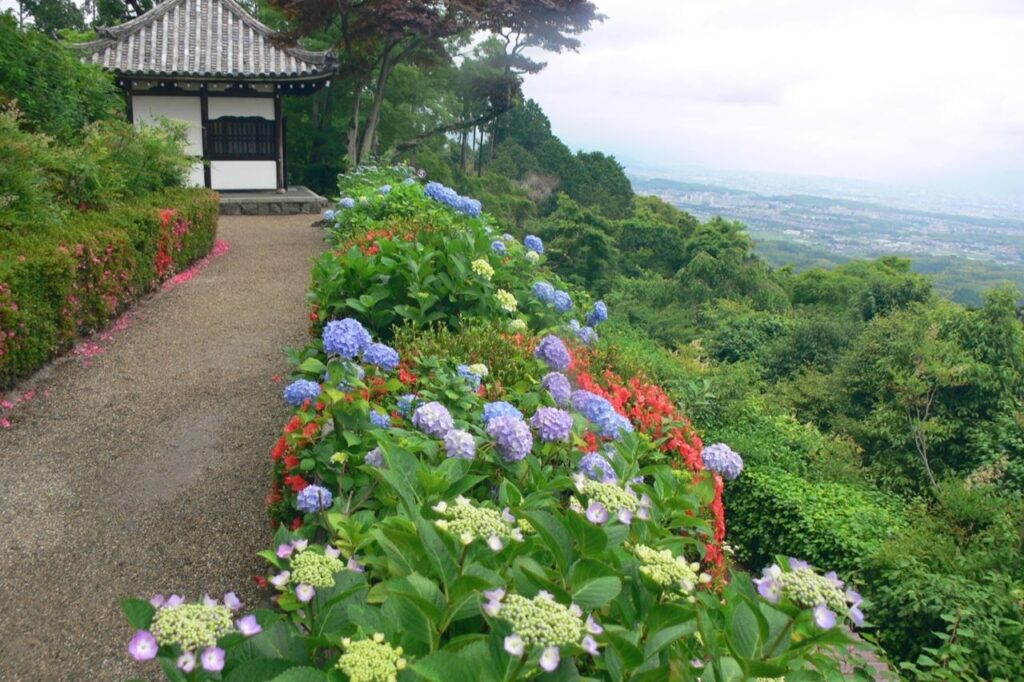

Best time to visit (usually): mid-June to early July
Entry hours: Saturdays, Sundays, national holidays 8:00 - 17:00, weekdays 8:30 - 17:00 (registration closes at 16:45 on all days)
Admission fee: 500 yen for adults, 300 yen for high school students, 200 yen for elementary and junior high school students
The Iwafuneji Temple is said to have been founded in 729 by the order of Emperor Shomu, and around 1937, the previous chief priest began planting hydrangeas to beautify the devastated grounds, which eventually became known as a famous place of worship. Today, the temple grounds are home to more than 5,000 flowering plants of more than 30 varieties, including the original mountain hydrangea and western hydrangea. The "tama-hydrangea," which blooms from round, bead-shaped buds, can be enjoyed from summer to early fall.
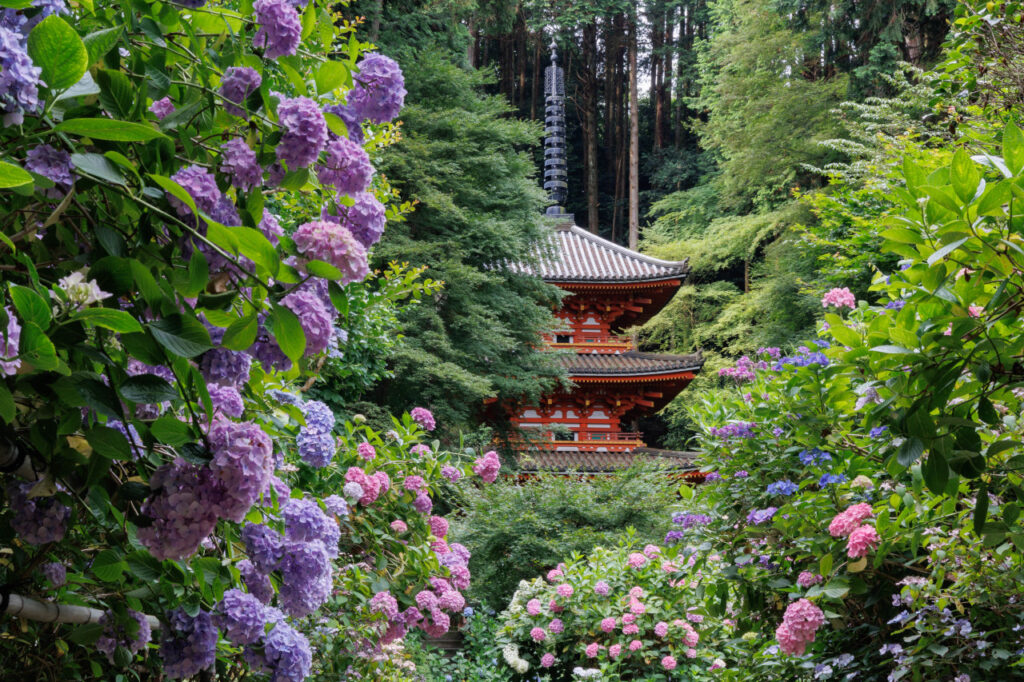
During the hydrangea season, water lilies can be enjoyed at the same time.

Best time to visit (usually): early June to early July
Hours: 8:30-17:00 (last admission at 16:45)
Entrance fee: 500 yen for adults, 400 yen for middle and high school students, 200 yen for elementary school students
Shinnyo-do Temple was founded in 984 (Eikan 2) and is the head temple of Hieizan Enryaku-ji Temple. Its official name is Shinsho Kyokuraku-ji Temple. Visitors can enjoy colorful purple, blue, white and other flowers around the bell tower and in the hydrangea garden. In addition to the contrast between the bell tower and the hydrangea, the elegant design of the water pots should not be missed.
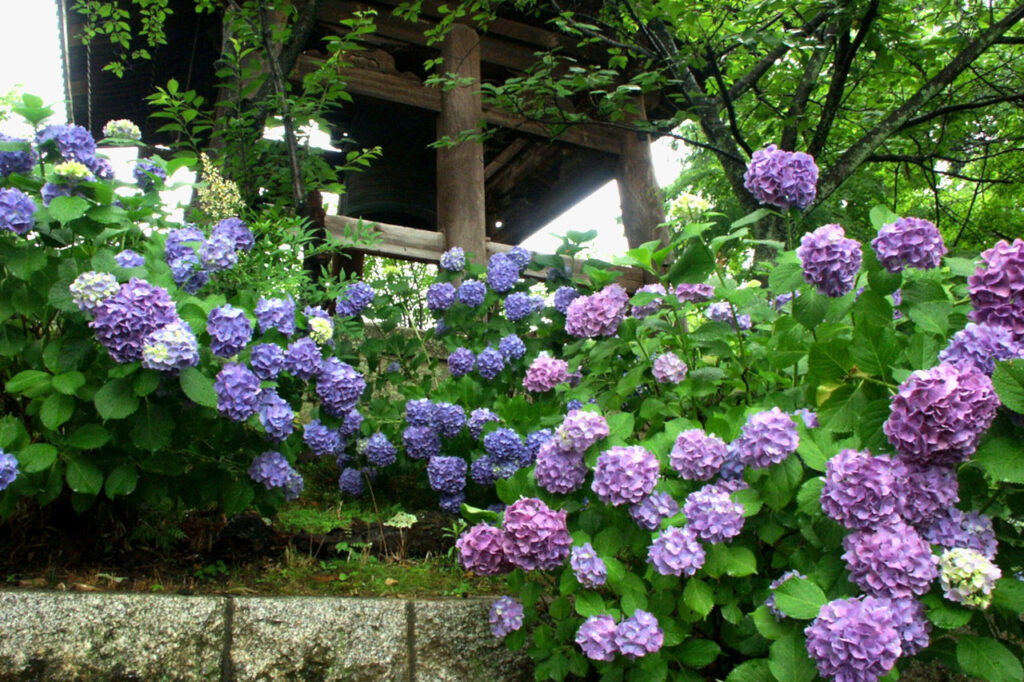

Best time to visit (usually): early June to early July
Visiting hours: 9:00-16:00 (reception closes at 15:45)
Admission fee: 500 yen for adults, 400 yen for junior high school students, free for elementary school students and younger
*Free of charge for those with a disability certificate
[The former villa of the Mitsui family, a wealthy merchant who made his fortune selling kimono in the Edo period, is located to the south of Shimogamo Jinja Shrine. The hydrangea garden will be open to the public free of charge for a limited time. About 400 hydrangeas, including gaku hydrangea, mountain hydrangea, and tama hydrangea, are planted in the garden and bloom in a variety of colors such as purple, blue, and pink. The white bellflowers, which are in bloom at the same time as the hydrangeas, have been planted this year in addition to the standard purple. Visitors can enjoy a more gorgeous view of the garden.
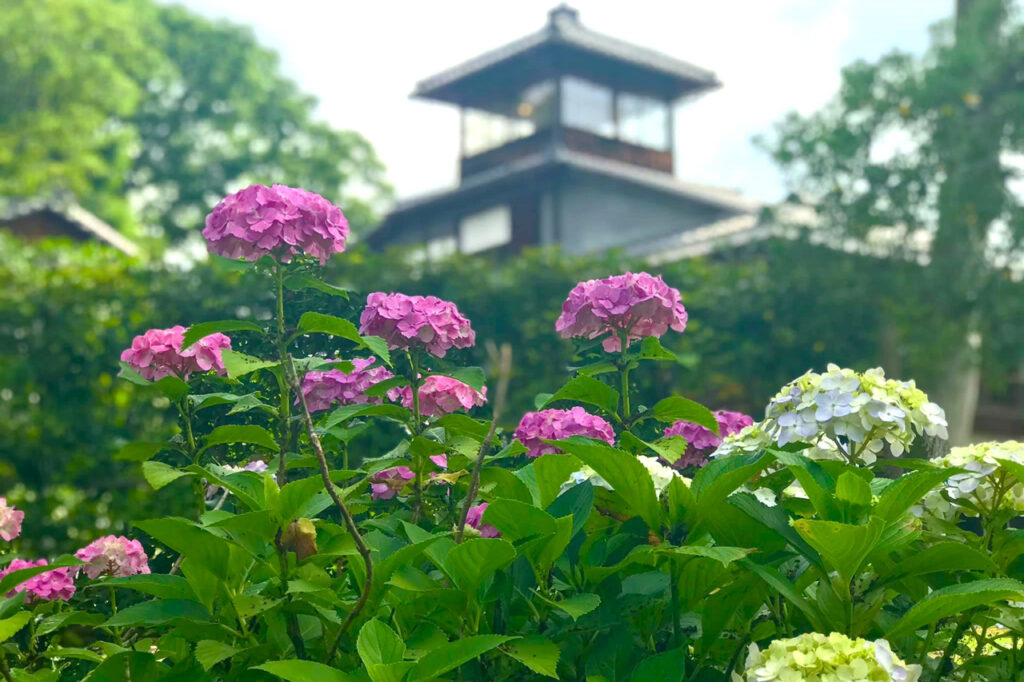

Free public viewing of the Hydrangea Garden
Best time to visit (usually): early June to late June
Period / June 15 (Sat.), 16 (Sun.), 2024 10:00-16:00 *The museum is open from 9:00-17:00 (last admission/16:30)
Free admission to the Ajisai Garden area only. Admission fee is required to visit the museum and the main garden area (600 yen for adults, 300 yen for junior and senior high school students, 200 yen for elementary school students).
Umemiya-taisha Shrine is famous as the god of childbirth and safe childbirth, and it is said that crossing the straddle stone will bring you a child. The garden is a garden with a view of Arashiyama and Kitayama, with 1,300 hydrangeas of 120 varieties, including tama-hydrangeas, blooming from the east to the north of the garden.
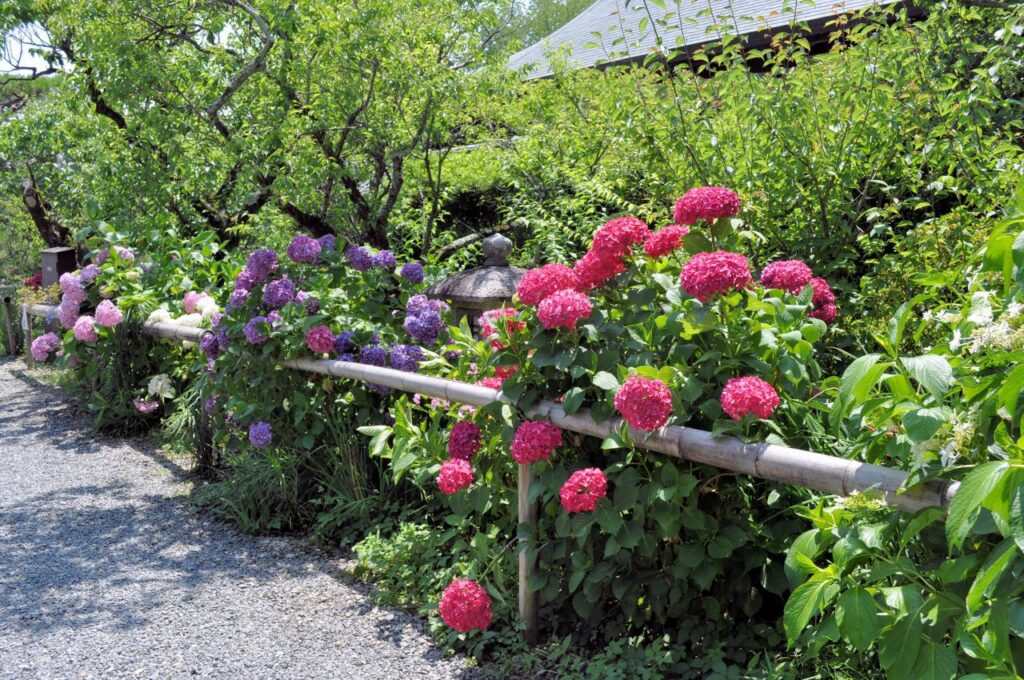

Best time to visit (usually): early June to early July
Hours of visitation: 6:30-18:00, Shrine Garden 9:00-17:00 (reception ends at 16:30)
Admission: Free in the precincts, 600 yen in the shrine garden, 400 yen for elementary and junior high school students.
Kanshuji Temple is the head temple of the Yamashina school of the Shingon sect of Buddhism. It is known as a famous flower garden, with flowers blooming from season to season. During the rainy season, blue hydrangeas around the Shikinden Hall and in the moss garden are at their best. The fresh hydrangeas against the rainy sky and the pure white hansatsu-sho are a sight to behold.
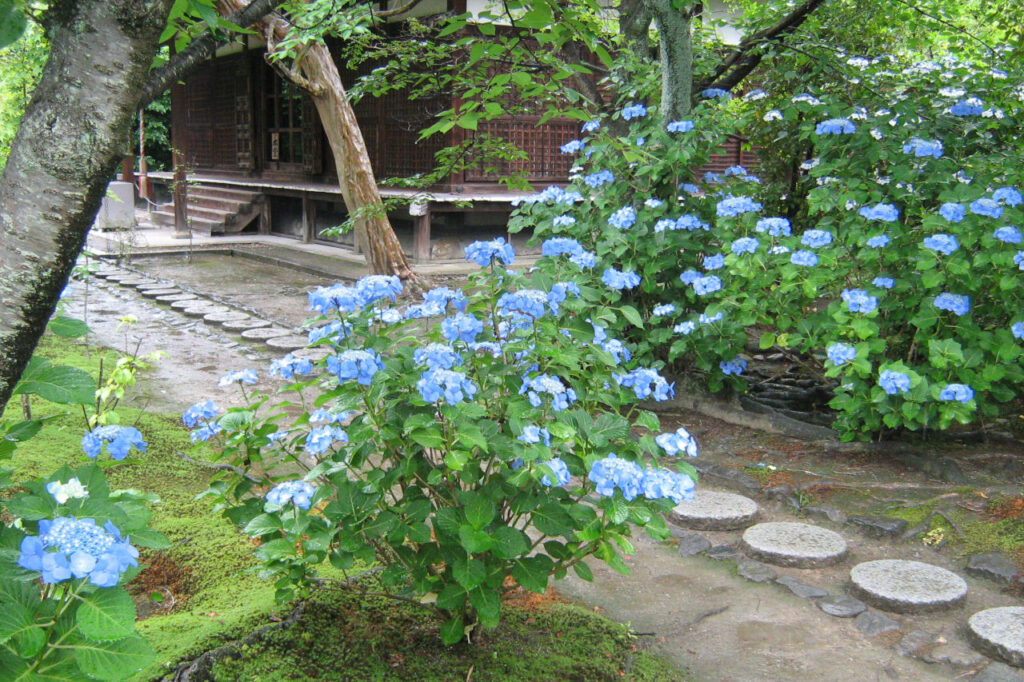

Best time to visit (usually): mid-June to early July
Visiting hours/9:00-16:00
Admission fee/500 yen
Yanggok-ji Temple is a place of prayer for the healing of eye diseases. The temple is famous for its hydrangeas, with approximately 5,000 in bloom. From the "hydrangea corridor" that runs from the Shoin to Okunoin, visitors can enjoy the hydrangeas that are at their best from early June to early July every year. In recent years, the temple has also become known as the "Temple of Flower and Water Fountain," and the flower and water fountain with hydrangeas floating in it is refreshingly beautiful. During the period, the Kamishoin, which was featured in an Idemitsu Kosan commercial, will be open to the public for a special viewing.
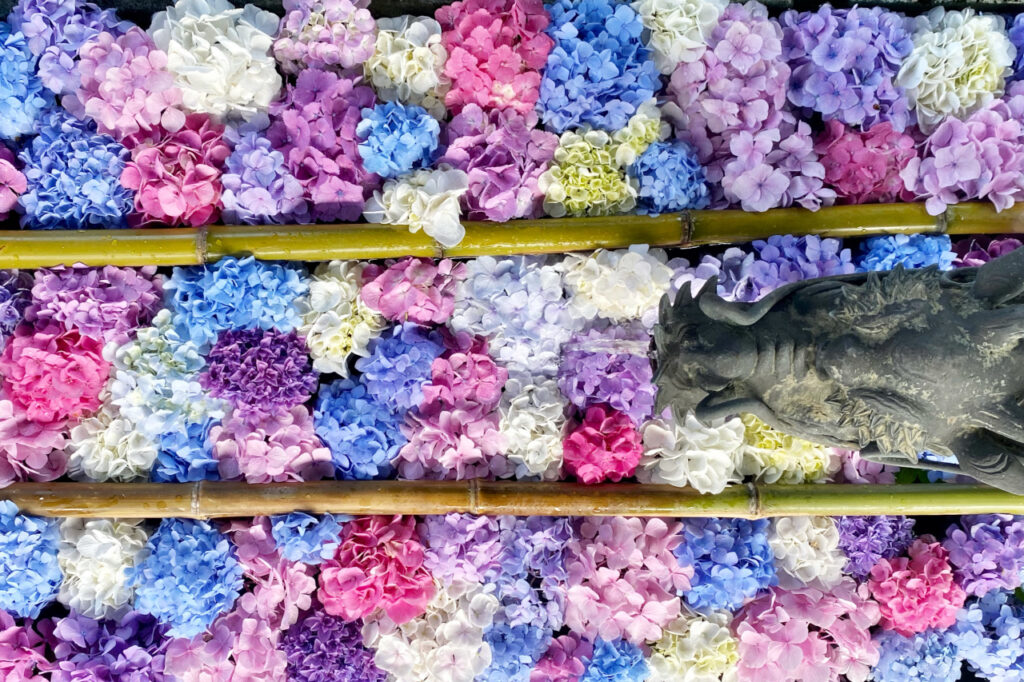

Yanagiya Kannon Hydrangea Week
Best time to visit (usually): mid-June to early July
Period / Saturday, June 1, 2024 - Sunday, June 30, 2024 9:00 - 17:00
Admission: Adults 700 yen, Free for high school students and younger
800 yen is required to visit Kamishoin (reservations accepted).
Hokkeumgo-in Temple is the head temple of Toshodai-ji Temple, a branch of the Ritsu sect of Buddhism. Hydrangeas adorn the promenade in the pond garden, which is designated as a special place of scenic beauty by the national government, creating a picturesque scene against the backdrop of the temple. The temple is also known as a temple of flowers. The temple is also known as a temple of flowers, with irises blooming in mid-June and lotuses in early July.
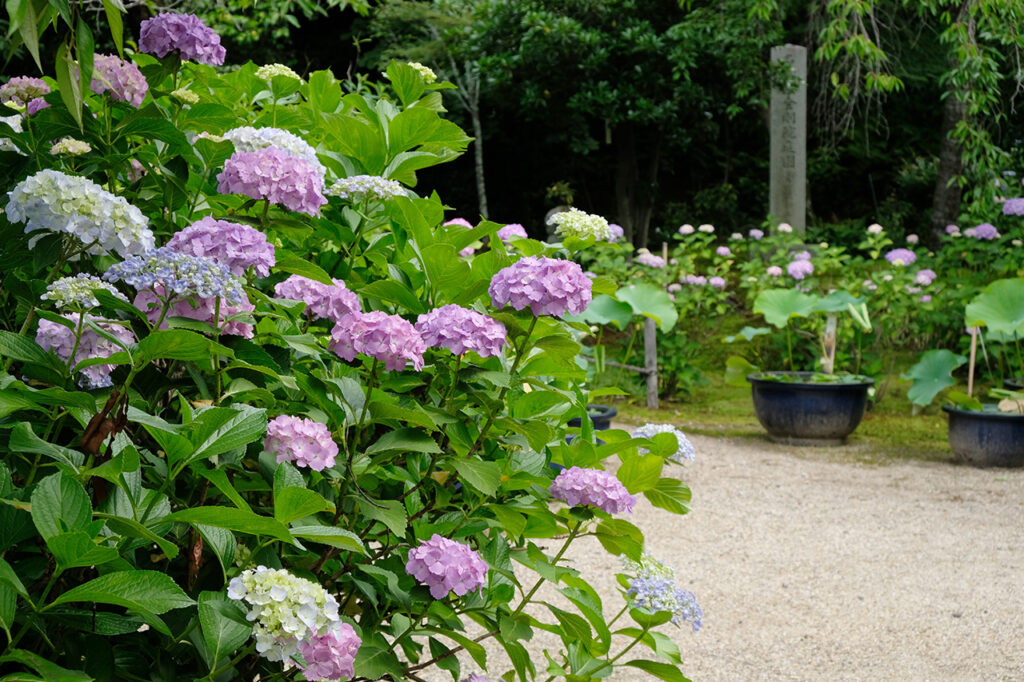

Best time to visit (usually): mid-June to early July
Date and time of visit/to be determined
The latest date and time for viewing isHPcheck
Admission fee/500 yen
Reigen-in Temple, the pagoda temple of Kenninji Temple, is known for its amacha (sweet tea). In 2020, "Kakumei Kyukou," a dry landscape garden, was redesigned as a "garden representing the life of Buddha," and is open to the public during the peak season of hydrangea.
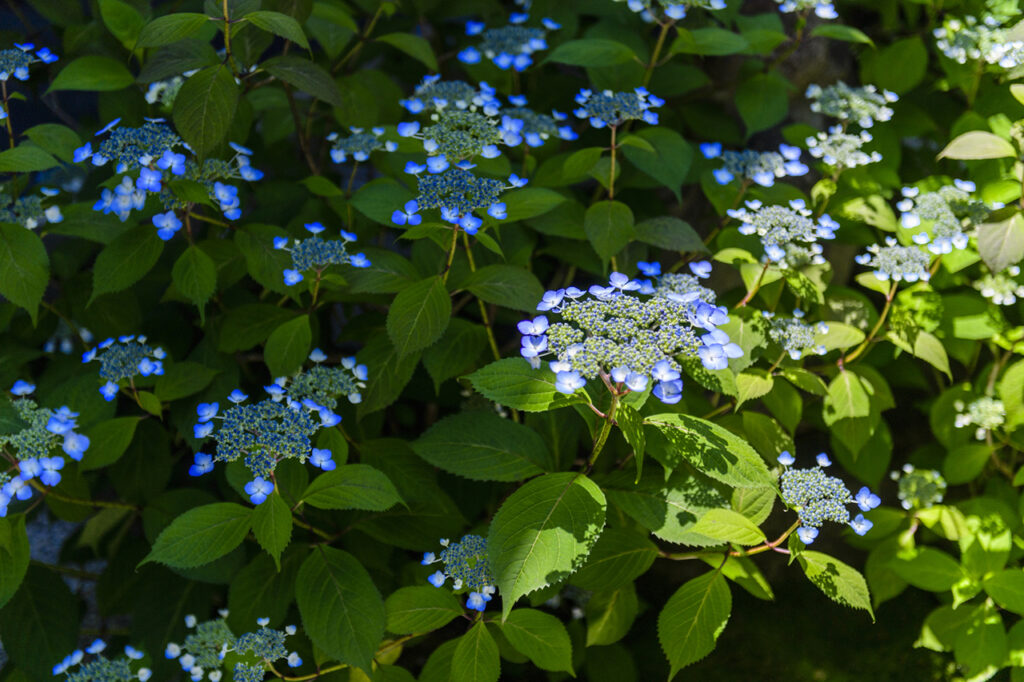

Completion of "Tsurumei kyusatsu", a garden for amacha, special opening to the public
Best time to visit (usually late May - early June)
Period: May 18 (Sat) - June 16 (Sun), 2024 11:00 - 15:00 (last admission at 14:30)
Admission: Adults 500 yen, Junior and senior high school students 300 yen, Free for elementary school students (accompanied by a parent or guardian)
Shoju-in Temple was built in 1200 as the pagoda temple of Iio-kyo-ji Temple. In addition to the heart-shaped window "Inome-mado" and 160 ceiling paintings, the "Fu-ring Festival" held every summer attracts much attention. More than 2,000 wind chimes are displayed during the festival, but only during the rainy season can visitors enjoy the cool wind chimes with hydrangea motifs. Try taking pictures of the Instagram-worthy hydrangea wind chimes at Shojuin, which is also called "Fu-ring-dera Temple.
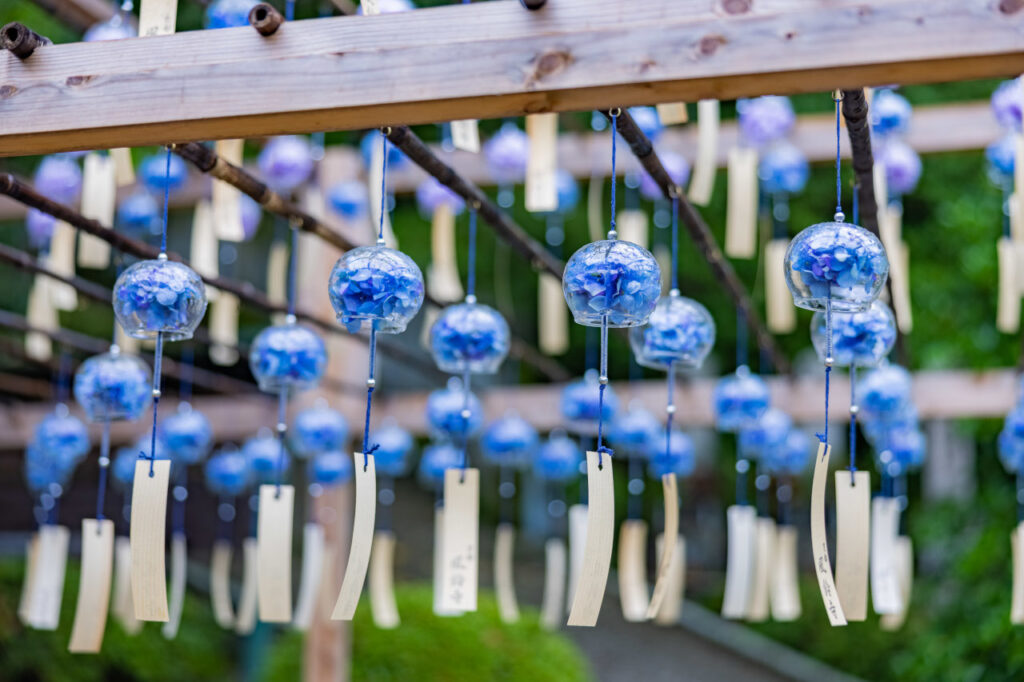

Holding the Wind Bell Festival
Period: June 1 - September 30, 2024 *Ajisai wind chimes will be available until early July
Admission fee (during the wind chime festival) / 800 yen (includes sweets)
Hours: 9:00-16:30 (last admission at 16:15)
Over 600 interviews per year! An order site carefully selected by the editors who knows Kyoto and Shiga.
nowOfficial LINE friend registration500 yen OFF coupon is being issued!
Distributed every Friday morning at 8:00 am! From new restaurant information to event information that we want to share with you, We deliver articles about Kyoto that are useful to know. About 20,000 people have registered.Click here to add a friend!
 News
News Feature article
Feature article Featured event
Featured event